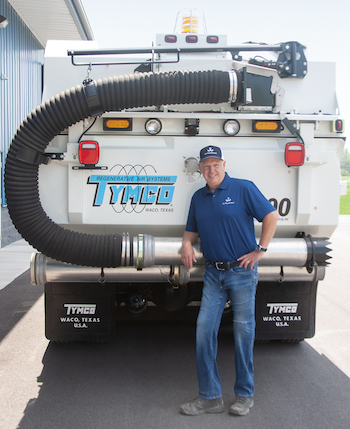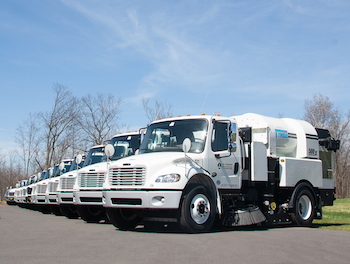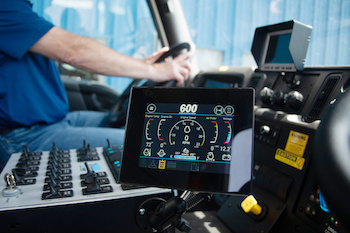Rental Center: Sweep dreams
J and J Equipment specializes in rentals and sales of municipal cleaning and maintenance equipment. It’s proven to be a great niche market.
By Clair Urbain
|
J & J EQUIPMENT BREWERTON, NEW YORK |
 |
| Lonergan says the company’s revenue is 60 percent equipment sales and 40 percent equipment rental. “That can vary widely, because these machines average at around $250,000 to $300,000 each,” he says. |
 |
|
Municipalities’ interest in rental units is increasing dramatically. “The price of equipment is driving this. If customers only need it for two months, they question why should they own it for the other 10 months of the year?” says George Lonergan, J & J Equipment owner. |
 |
|
Lonergan has 42 street sweepers in his rental fleet and they have nearly 100 percent utilization in the spring, summer and fall. “We also have some asphalt-patching units in the fleet that are in demand in late winter and early spring,” Lonergan says. This image was taken early spring before the rental units were dispatched. |
"I had a passion for street sweepers,” says George Lonergan, owner of J and J Equipment, a sales and rental dealer for maintenance and cleaning equipment primarily to municipal customers.
“I was always intrigued by street sweepers by the way they cleaned the road. I remember watching them go by the house when I was a kid, and I always thought they were the neatest machines.”
George’s father was in the equipment business and represented TYMCO street sweepers. “When I started working for my father in 1988, I got involved with street sweepers. I went to a service/sales school in the spring of 1989, and I came back from that school very excited. I would pack a suitcase and drive all over upstate New York, basically from Albany to Buffalo, visiting different towns and villages to tell them about TYMCO street sweepers. It’s the way things were done back then. There were no cell phones. There wasn’t email,” Lonergan recalls.
Early years
The competition was fierce with two very well-established companies that had a corner on the municipal market. “It took me awhile to get a few machines out there, but once I did, the sales to municipalities and contractors serving airports, landfills and others needing street-sweeping equipment started taking off in the ’90s.”
The September 11, 2001 crisis hit the family business hard, and at the counsel of his father, George left the company to start his own business as a TYMCO distributor. By then, he and his wife, Carol, had two sons, Jared and Jack, so J and J Equipment was born.
Today, Jack is a service technician for the company; Jared has started a trucking company – Lonergan Trucking – and is very active in the National Guard. Their youngest son, George, is still in high school. In addition to street sweepers, Lonergan is a distributor for Loadmaster garbage trucks, RC (remote controlled) Mowers, Aries Industries inspection cameras, Cimline and KM International asphalt repair and maintenance equipment, Superior Broom sweepers, Dyna-Vac sewer line cleaners and vacuums and Fair Equipment’s line of snow-handling equipment.
The rental fit
Lonergan says the company’s revenue is 60 percent equipment sales and 40 percent equipment rental. “That can vary widely, because these machines average at around $250,000 to $300,000 each,” he says. “However, the sales cycle to municipalities and contractors for these types of machines is about 10 years. Most municipalities work through agencies such as Sourcewell, which can be compared to Amazon but is for municipalities to shop for equipment. They buy from the manufacturer directly, then as the servicing dealer, we deliver and support the unit.”
His equipment sales are not financed in-house as a rule. “Rental lease programs aren’t common with municipal customers,” Lonergan says.
However, municipalities’ interest in rental units is increasing dramatically. “The price of equipment is driving this. If customers only need it for two months, they question why should they own it for the other 10 months of the year?” he says.
Today, Lonergan has 42 street sweepers in his rental fleet and they have nearly 100 percent utilization in the spring, summer and fall. “We also have some asphalt-patching units in the fleet that are in demand in late winter and early spring. We have truck-mounted patcher units, called the DuraPatcher, that is our most expensive piece to rent at $11,000 a month, but they also
cost $300,000.”
To meet the rigorous sweeper schedule, Lonergan’s crew brings units back to the shop, inspects them and makes any repairs, then gets them ready for delivery to the next renter. It must go like clockwork, and because sweepers are complex, hydraulically driven units, Lonergan keeps an extensive parts inventory. “These machines work in dusty conditions, picking up all sorts of materials. Although they are built for working in this type of environment, parts wear and failures happen.”
“Our parts strategy is that if we replace any part three times in a year, we will carry it in inventory. That has worked well for us. We are able to get machines back out in a day in almost all cases,” he says.
Renting to municipalities is very much like renting to contractors, Lonergan says. “Municipalities are very loyal customers as long as you service them. They like convenience and they like dependability; and so do contractors. But with a municipality, you have a customer for life if you take care of them.”
Presently, Lonergan and his long-time assistant, Lyn Young, run the company. He also has two outside salesmen and four people working the service department. They moved into their most recent location that has 8,000 square feet of shop space and 2,500 square feet of office and meeting space less than two years ago. “Our original location was really a pole building with only one overhead door. It was very efficient for equipment repair and servicing. The new building has eight bays with drive-through overhead doors,” he says.
Lonergan attests to the quality of his staff – he had a serious snowmobiling accident in 2013 that left him gravely injured. He had multiple surgeries that included two leg amputations and a week-long medically induced coma with a very poor prognosis.
“I sold two sweepers while I was in a coma. I’d like to say I am that good of a salesman, but really, it’s because I have a great staff backing me up. They have been great support both personally and professionally,” he says.
Alternative power
Lonergan sees great promise in alternative-powered equipment in the future. “There’s a ton of opportunities in this industry. The technology of what this equipment will run on in the future will be very interesting. Is it going to be electric-powered, CNG-powered, or something else? Dealing with emissions produced by sweepers, which are diesel-powered, means they are all Tier-4 Final-compliant units. They use DEF technology. We’ve seen some manufacturers now offering alternative fuel options. I think much of it’s going to be electric,” he says. With Volvo and General Motors offering electric-powered vehicles, Lonergan believes that’s the future in the environmental equipment market he serves.
Similarly, Lonergan sees telematics and GPS location services to be a boon for equipment rental and sales operations. “Our TYMCO sweepers use BlueLogic systems that tracks all maintenance and records how the machine is used. We can see how many hours the equipment is used for which functions. I can only see this information becoming more valuable and actionable as time goes on,” he says.
Lonergan also predicts an increasing trend toward remote-controlled equipment, especially in difficult or hazardous work environments. “We’ve gotten great interest in our RC Mower line because it allows municipalities and water control agencies to mow steep banks without putting an operator in danger. Will there be a street sweeper that goes down the road autonomously sweeping streets in 20 years? We will see,” he says.
As Lonergan looks to the future, he is most concerned about how and if his children will be interested in coming into the business. “I think the thing that keeps me going is having my children come of age and seeing what their interests are in the business as they get older. Hopefully, they want to continue with the family business. Time will tell.”
This article originally appeared in the July-August issue of Pro Contractor Rentals magazine. © 2021 Urbain Communications LLC. All rights reserved.









